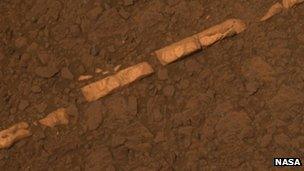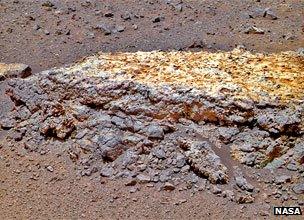Mars rover Opportunity finds 'most powerful' water clue
- Published

"Homestake": The gypsum vein is just 1-2cm wide
Nasa's Mars rover Opportunity has found slivers of a bright material that looks very much like it is gypsum (calcium sulphate).
If confirmed, it would be the most unambiguous signal of water activity yet found on Mars by this mission, which manages to keep on rolling.
Creaking and arthritic it may be, but after nearly eight years, the rover is still delivering remarkable science.
Lead scientist Steve Squyres said the find was "so cool".
"To me, this is the single most powerful piece of evidence for liquid water at Mars that has been discovered by the Opportunity rover," the Cornell University researcher told journalists.
"We have found sulphates before. Those sulphates were formed somewhere - we don't know where.
"They've been moved around by the wind, they've been mixed in with other materials - it's a big, jumbled-up, fascinating mess.
"This stuff formed right here. There was a fracture in the rock, water flowed through it, gypsum was precipitated from the water. End of story. There's no ambiguity."
Prof Squyres was giving an update on the rover mission here at the 2011 American Geophysical Union (AGU) Fall Meeting, external, the largest annual gathering of Earth and planetary scientists.
Opportunity was put on the Red Planet back on 25 January, 2004, with the expectation that it would complete at least three months of operations.
But the robot has exceeded everyone's expectations and continues to operate despite some worn mechanisms and instrument glitches.
Since its landing on the Meridiani plain just south of Mars' equator, the robot has trundled more than 30km to the rim of a huge crater known as Endeavour.
Acid test
Opportunity is currently investigating a raised piece of ground referred to as Cape York where it has found two exciting new rocks.
Steve Squyres: Opportunity "in astonishingly good shape"
One is the gypsum - if that is what it is. It takes the form of a narrow vein about 1-2cm wide and about 40-50 centimetres in length.
Opportunity has examined the deposit using its Microscopic Imager, its Alpha Particle X-ray Spectrometer and the multiple filters of its mast camera.
All the indications are that this vein is relatively pure hydrated calcium sulphate, although some further analysis will be required to put all doubts to bed.
Like all the interesting deposits examined by Opportunity, the vein has also been given a name. The science team has called this one "Homestake".
The other new rock of note found by Opportunity is nicknamed "Tisdale". It has a zinc concentration higher than anything previously seen by Opportunity.
The concentration is so high in fact that it approaches levels seen in commercial zinc ores here on Earth.
Invariably, such deposits are the result of hydrothermal activity - hot water flowing through rocks and laying down zinc-rich minerals.
The team cannot exclude the possibility just yet that the zinc may simply be a thin exterior coating. Future studies will have to establish the zinc goes right through Tisdale or similar rocks in the area. If that can be done, it would put the hydrothermal theory on a firmer footing.

"Tisdale" displays a strong zinc signal
All of Opportunity's findings are helping to fill in a story about a wetter, warmer Mars that existed billions of years ago.
As always, such discoveries raise absorbing new questions about the possibility that simple lifeforms could have existed during these ancient times. In this respect, the gypsum discovery makes the potential for habitability more likely.
"The gypsum is intriguing because it allows the possibility - although it does not require it - that the water was not as acid as some of the other waters that we've seen evidence for," Prof Squyres told BBC News.
"The other waters... were probably very acidic - pH of five, four, three. Gypsum doesn't require that, and so this may hint at a kinder, gentler chemistry of the water for life."
Opportunity's operations will slow in the coming months as it conserves energy to make it through a fifth Martian winter. During winter, the amount of sunlight reaching its solar panels is reduced, and high-energy activities like driving are kept to a minimum.
It currently costs Nasa about $12m a year to run the mission. Given the rover's current status and performance, the space agency could be continuing to spend such money for a few more years yet.
Only two other wheeled space vehicles have travelled further than Opportunity. The Lunokhod 2 rover that the Soviets sent to the Moon in 1973 covered 37km, and the American "Lunar buggy" deployed with Apollo 17 covered 36km.
But Opportunity, which has completed 34km, should overtake both.
"It's the only horse competing in this particular derby," observed rover project scientist Bruce Banerdt.
- Published26 November 2011
- Published24 November 2011
- Published14 October 2011
- Published25 May 2011